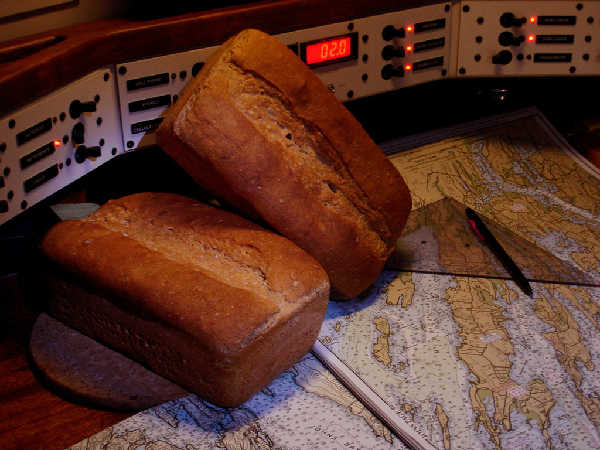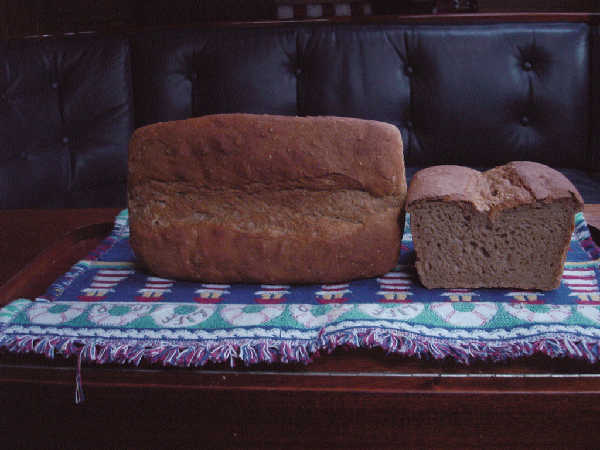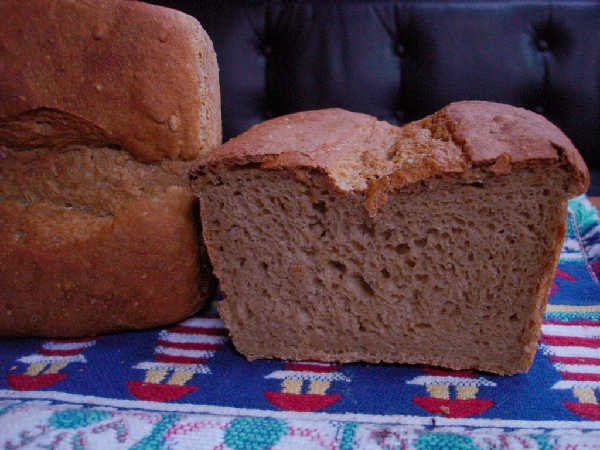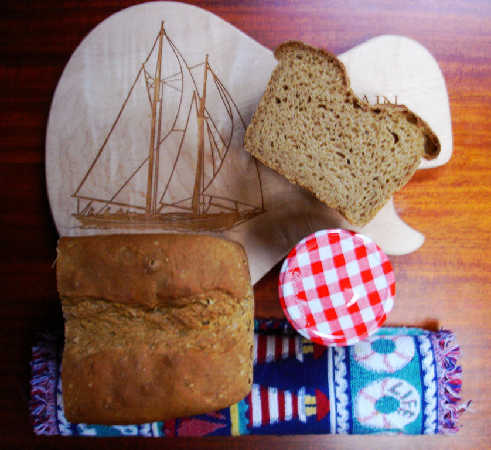
Xma commented about trying seawater in bread on a diving trip. I decided to give this a try.
Please note: I have not researched health hazards that may result from using raw seawater directly in bread dough.
Based on some discussion on the internet, it seems that seawater has a salinity of approximately 32 to 35 parts per thousand. However, not all of the ions are Na+ or Cl-. In fact, seawater is a complex combination of various salts. However, as a naive assumption, I used 3.2% grams of salt per grams of water to approximate the saltiness of the seawater. One of the web sites indicated that the salinity in the Gulf of Maine, where I baked this bread aboard my sailboat, was 32 parts per thousand.

One of our crew members was able to obtain some KA White Whole Wheat Flour at a store in Portland on the way down to the docks, so we decided to make a whole wheat pan loaf. Just in case, a jar of percolating Glezer firm starter, fed the night before, was hidden in my duffel bag waiting for the grand seawater bread baking experiment.

We arrived at the docks and boarded "Chaos" a 40 foot sloop, and set off from Portland after having quickly fed the culture 1:2:2, expecting it rise again and then ripen a bit in time for an evening of a firm "recipe starter" preparation. We collected our seawater by using a seawater foot pump to draw seawater into bowls in the galley sink when we were at the eastern end of Casco Bay, about 1/4 mile southeast of White Bull Island, not too far from Cape Small. The winds were light, so we ghosted along, hardly spilling a drop of seawater. We therefore had plenty of our valuable test sample to use in the dough when we arrived in The Basin, a beautiful completely enclosed harbor on the eastern side of Casco Bay.

Seawater Sourdough Whole Wheat Recipe
Ingredients
Please see a spreadsheet with quantities in grams and ounces and baker's percentages.
Recipe Starter:
- 114 grams (4 oz) of fully active, ripe 100% Hydration Starter (In my case I took my Glezer firm starter and fed it 1:2:2 with KA White Whole Flour and water such that I would have approximately equal weight flour and water, and allowed this to ferment for about 8 hours)
- 283 grams (10 oz) whole wheat flour (I used KA White Whole Wheat flour, which is what was available)
- 198 grams (7 oz) water
Dough:
- 652 grams (23 oz) seawater drawn from the coast of Maine at the east end of Casco Bay off of White Bull Island near Cape Small (if you draw the water from another location, you may need to consider the variation in salinity in different parts of the ocean in your calculations, or mix 32 grams per liter of fresh water and use as a seawater substitute).
- 99 grams (3.5 oz) fresh water. (I used water from the freshwater tanks, of dubious origin - the dock supply in Portland - laced with a touch of bleach to keep the tanks "sweet").
- 850 grams (30 oz) whole wheat flour (I used KA White Whole Wheat Flour)
Starter Preparation
I brought along a small amount of my new Glezer firm starter, thanks to consulting extensively with Zolablue, who has a thriving Glezer style firm starter and lots of great sourdough bread to prove it. I fed this starter with KA White Whole Wheat flour using the following: 32g Glezer starter:88g fresh water:80g KA WW. The mixture was stirred and allowed to rise while we sailed from Portland to The Basin in Casco Bay. Fortunately, it was a warm day, so the starter did rise just fine and was reasonably ripe later on in the afternoon when we made the recipe starter.
Recipe Starter
Around 6 P.M. the recipe starter was mixed. First add the recipe starter water to the 100% hydration starter and stir to fully mix the starter in the water, then mix in the flour. Knead into a dough, which should take about 3 minutes of kneading or less. Cover and allow to ferment until at least doubled. In this case, the temperatures were around 65F, and dropped down to about 55F over the course of the night, so we just allowed the starter to ferment all night. At room temperature, it would have taken about 5-7 hours to double this dough with my starter - your mileage will vary greatly of course.
Hydrate Flour
According to advice from whole grain experts, and realizing that seawater might impede the proper hydration and gluten formation in my KA White Whole Wheat Flour, I decided to give it a good long overnight soak in the seawater.
Mix seawater and freshwater together into a mass, cover, and allow to rest overnight in the refrigerator, or in our case, on the salon table where the temperature dropped down to about 50F overnight.
Mix Dough
In the morning, we mixed the dough. Take the mass of flour and water and lay it on a slightly wet counter and spread it into a large round disk like a pizza. Cut up the recipe starter into small pieces and push them into the larger flour mass, like toppings on a pizza. Roll up the dough and fold it a few times to begin mixing the starter with the dough. Since the hydration of this dough is fairly high, the starter and dough should mix together quickly and easily. I started the gluten formation and continued the mixing by spending about 30 seconds doing the following. Wet your hands and pick up one end of the dough, allow it to stretch with gravity, toss the other end on the table and pull it toward you, then flip the end you are holding over the dough in a folding action and pull your hands out and rewet them if necessary. Repeat this action a few times, rotating the dough each time.
Once the dough is well mixed and folded a few times, let it rest covered for an hour.
Fold Dough Periodically
To develop the gluten, fold it about once per hour for the first 3-4 hours. Some of my other blog entries (miche recipes) describe the folding technique, and there are even some photos of the steps. Hamelman describes the technique in "Bread", as well. This dough should rise in about 4.5 hours at room temperature with my starter. Again, your mileage will vary. However, it was cold on the boat. The dough started at a temperature of 55F. Luckily the sun managed to come out for a while and it warmed up, so the boat warmed up to about 70F for a few hours later on in the day. While we were sailing to Christmas Cove in Muscongus Bay, Maine, the dough rose nicely by a little more than double. The extra unexpected warmth probably resulted in a slightly overfermented dough, but not by much.
Shape Loaves and Final Proof
Two loaves were shaped approximately into batards, with the ends folded under, using JMonkey's video instructions. However, the dough was very wet and was a little too fermented, so it wasn't quite as easy as it looks in the video. Good luck - stay calm and don't overhandle the dough. Place the loaves in greased pans and cover. We placed the loaves in plastic bags and folded the opening to create a balloon for them to rise in.
Slash and Bake
Normally these loaves would proof in about 2.5 hours at room temperature. The boat was luckily at about room temperature, but we were also having too good a time cooking dinner and enjoying an after sailing happy hour. The boat warmed up inside, we had dinner, and before we knew it, the loaves had proofed for about 3 hours in the mid-70s. They seemed overproofed, but I tried slashing them anyway. At least they didn't collapse.
We baked in our anemic boat oven from a cold start for 1.5 hours at "400F", which means that it may have reached 400F at the very end of the bake, if that. Someone reflexively turned off the gas safety valve at that point, so although the loaves were just beginning to brown, we didn't realize the bake was over and the oven was off. These high hydration loaves do benefit from a good long bake, so our crumb turned out a little moist and the crust a little light. Still, the bread was good.
Results
The flavor was very good - not overly sour at all, but definitely a sourdough loaf. I am not a big fan of white whole wheat, but that's what happened to be available in the store. I don't know if the flour itself contributed a slight bitter flavor, or if this was a side effect of the seawater. While reading about how salt is made from salt water, I discovered that the process is more elaborate than just evaporating seawater and keeping what remains. Usually a series of evaporator ponds are used which allow some of the less desireable salts to precipitate out before and after the desired sodium chloride we know as ordinary salt is extracted. Some of the less desireable salts were said to have bitter flavors. So, it may be that I have effectively used "low quality" salt that has contributed a bitter flavor to the bread by using seawater. The bread was calculated to have 1.8% salt in baker's percentages, based on a salinity of 32 parts per thousand for Gulf of Maine seawater, yet it tasted less salty than that to me. There are seasonal variations I didn't try to take into account. Also, it seems salt in seawater is about 85% sodium chloride, if I read some of the discussions correctly, and maybe the salty flavor is only imparted by the sodium chloride and not by any other salts. If so, then I needed to increase the seawater or add a little more salt to make up for that.